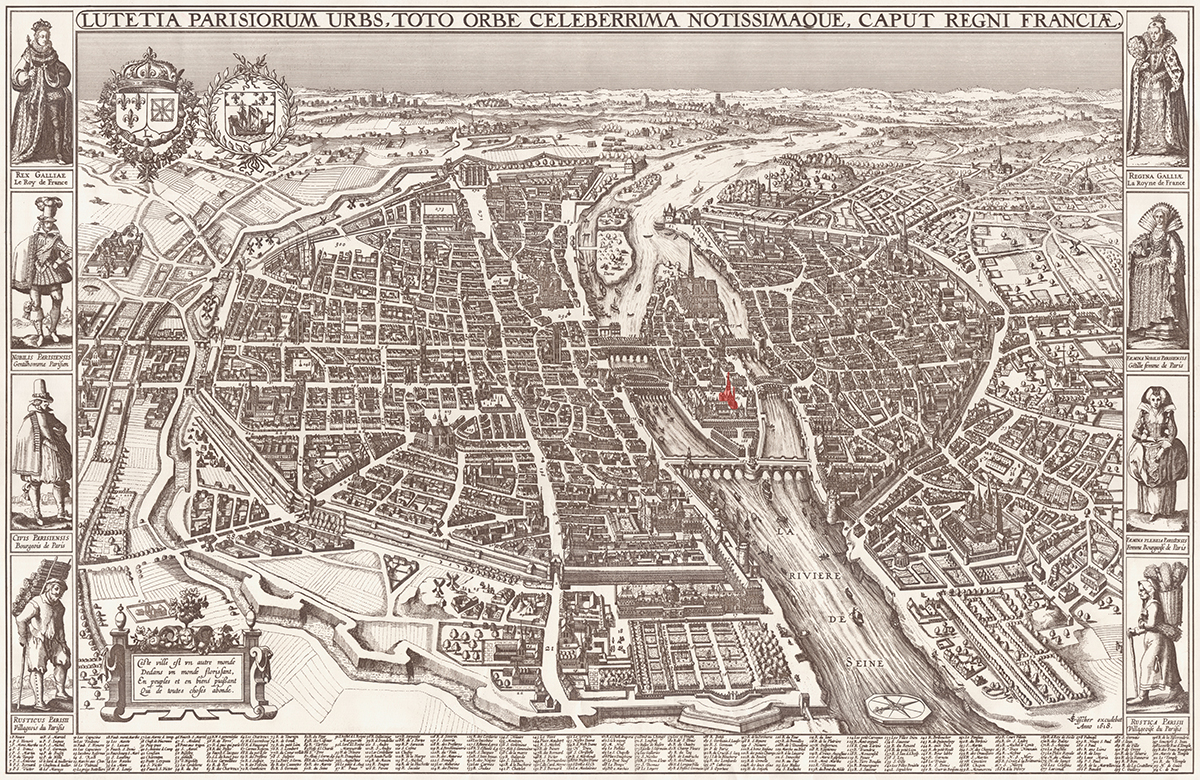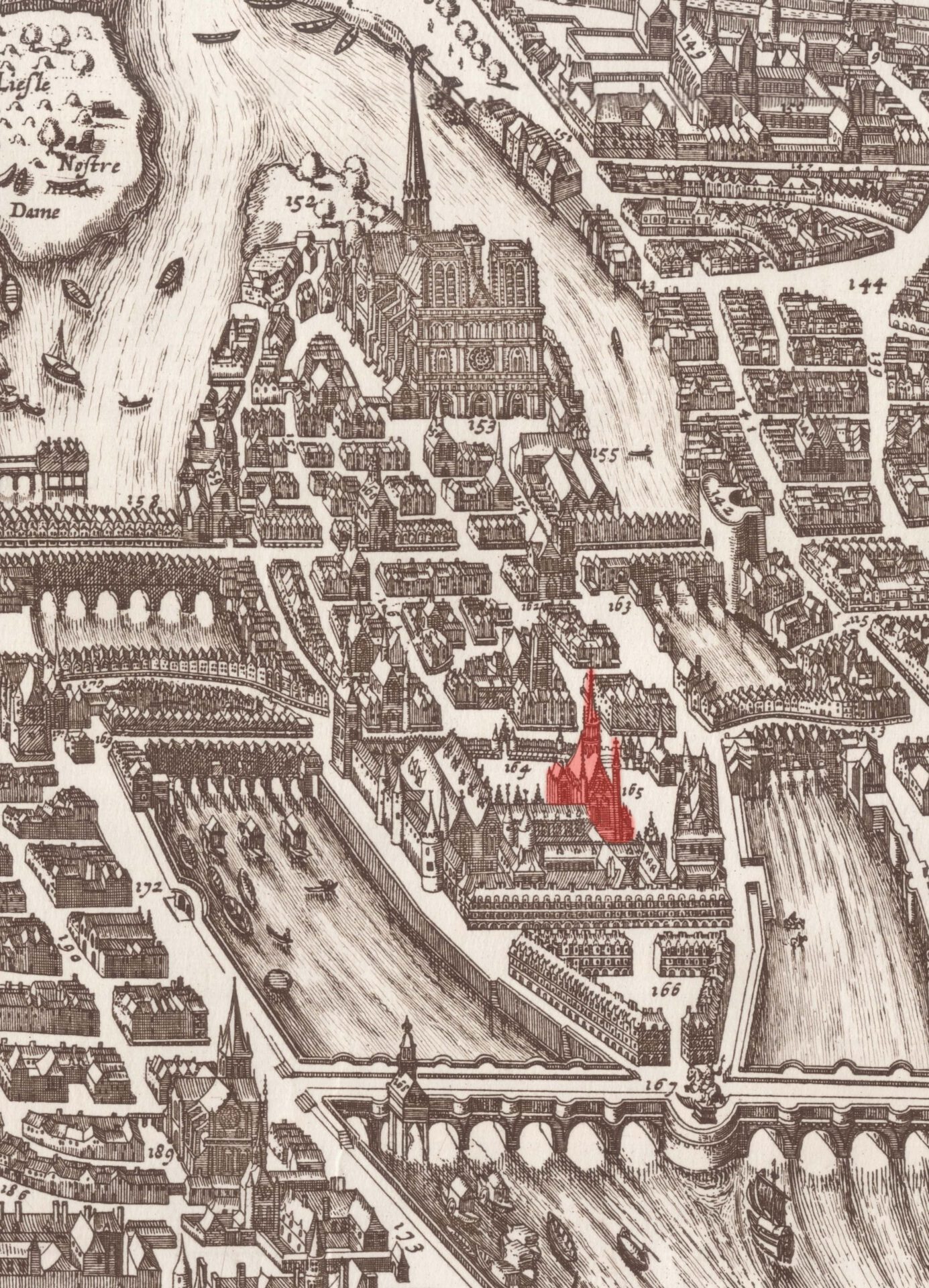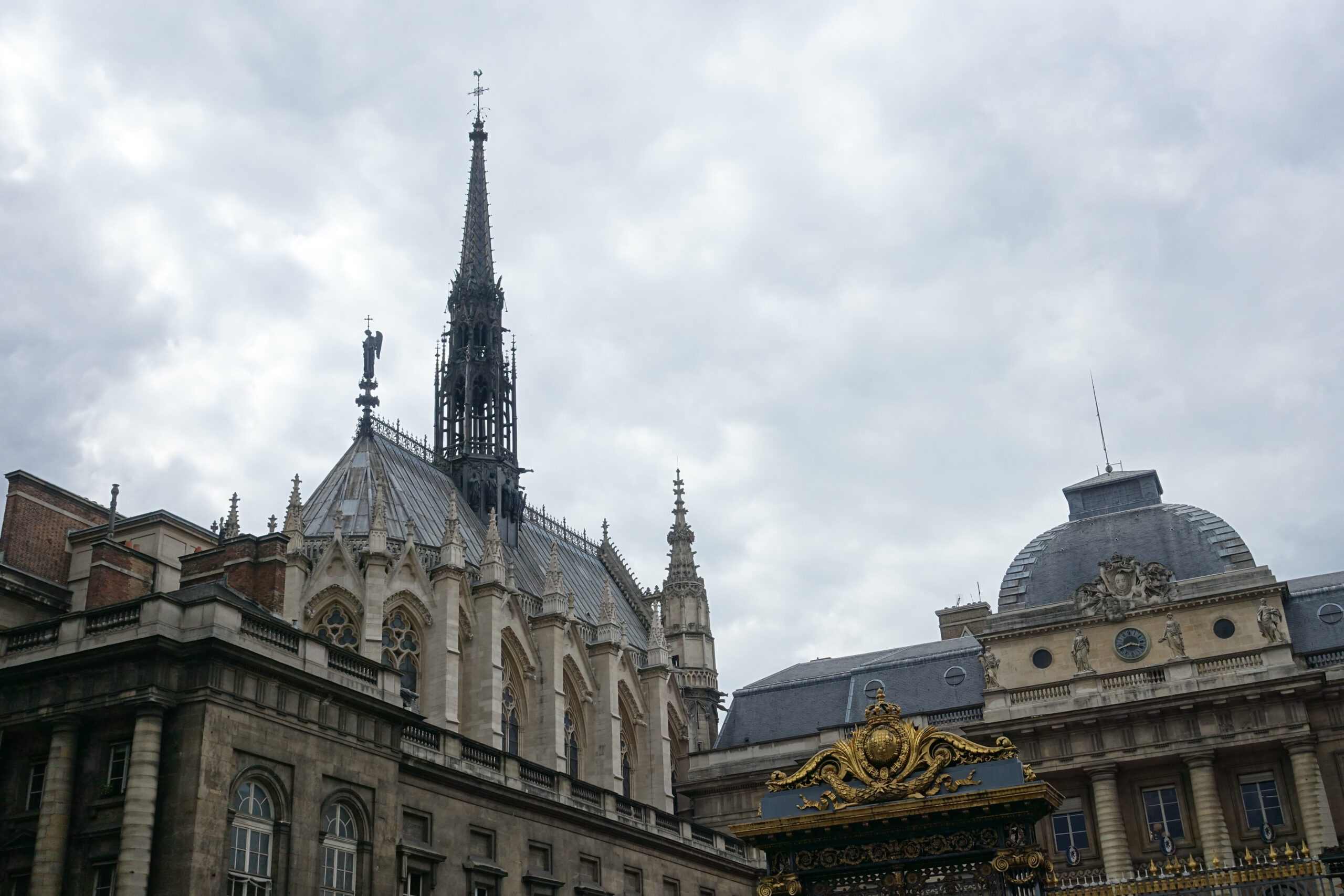
Sanctity and Royalty: Housing the Crown of Thorns at Sainte-Chapelle
Introduction
Sainte-Chapelle housed the Crown of Thorns for over 500 years, from the Middle Ages to the French Revolution. Situated within the palace walls, Saint-Chapelle stands to this day as a reliquary chapel. Entering the structure, the first thing that strikes the visitor is the extensive use of stained glass and the Gothic sense of elevation. However, the Crown of Thorns is no longer housed in Sainte-Chapelle. The separation of the reliquary chapel and the relic marked the modernization of France.
The Construction of a Multivalent Monument
Commissioned by King Louis IX (1226–70) of France, the construction of Sainte-Chapelle began in 1239 and was completed by 1248. It was built in the Rayonnant style, characterized by the radiating design of its rose windows, extensive use of stained-glass windows and their enlargement, thinning of vertical supports, and combination of clerestory and triforium that transforms the panels of glass into one large, glazed screen.1 In Meredith Cohen’s helpful summary on the historiography of Sainte-Chapelle in her book, The Sainte-Chapelle and the Construction of Sacral Monarchy: Royal Architecture in Thirteenth-Century Paris, she discusses Robert Branner’s 1965 argument that royal patronage had given rise to what he termed the Parisian “court style” in the thirteenth century.2 Branner’s term has since received various scholarly commentary and revisions—Cohen herself is inclined to characterize Sainte-Chapelle as belonging to the Rayonnant style, the prevailing ecclesiastical style of its time.3 The disputes of its taxonomy notwithstanding, from the moment of Sainte-Chapelle’s commission and construction it was destined to have both overt royal and religious associations. Louis IX—canonized posthumously as Saint Louis—had ordered the construction of Sainte-Chapelle for the express purpose of housing the Crown of Thorns and accompanying relics.4
The two-level Sainte-Chapelle served a range of functions. It operated not only as a reliquary chapel, but also as a parish one, and was employed as part of the king’s household. King Louis IX and his queen Margaret had their own designated seats—there are two niches built into the interior, the king’s on the north side and the queen’s on the south—in a screened off section that is closest to the altar, and the tribune screen and baldachin where the relics were placed.5 (Fig. 1)

This arrangement effectively characterizes Sainte-Chapelle as a royal space. Branner also identifies Sainte-Chapelle as, though importantly not the same as the capella regis (which was an itinerant office that followed wherever the king went), “one of the chapels royal, well endowed and having a body of resident canons.”6 Rachel Weiss, in making the case for the now destroyed Trésor des Chartes—a thirteenth-century, three-storied structure attached to the northeast end of Sainte-Chapelle—having been an integral part to the chapel, discusses the use of the third floor of this structure as the royal library and archives.7 As such, Sainte-Chapelle would have been not only linked with the king’s religious life, but also his administrative duties. On top of being a royal chapel, Cohen also argues that Sainte-Chapelle was—perhaps paradoxically at first glance—created to serve a wider public audience.8 Records of the liturgy and indulgences provided by Sainte-Chapelle provide evidence that members of the public flocked to the chapel for services and feast days.9 The most significant function of Sainte-Chapelle, however, is that of a monumental reliquary—Louis IX would probably have agreed himself, seeing that he commissioned it for this very purpose. What cements this fact is the papal bull of 26 May 1244 issued by Innocent IV, which describes Sainte-Chapelle with the phrase “opere superante materiam,” meaning “the workmanship surpassing the material.”10 As Branner elucidates, the phrase was commonly applied “almost always with reference to metalwork, jewelry, and objects of brilliance and intrinsic value.”11 In other words, what Sainte-Chapelle was to be was a reliquary wrought out of gold and silver and precious stones.
The Beauty of Sainte-Chapelle—“One of the Best Chambers of Paradise”
The relatively simple exterior of Sainte-Chapelle may hint little at the richness within, but its dazzling interior is heavenly.
The actual architectural plan is elegant in its simplicity as visitors walk into the open space in the one long nave. As Cohen remarks, most structural elements such as buttresses are relegated to the exterior to achieve this effect.12 Inside, all elements at least seem to serve aesthetic purposes only. Naturally there are the rib vaults that channel the ceiling’s weight, but they are highlighted in golden yellow so that they shine like precious metal, and also seem to echo the studded stars against the stylized blue heavens. The upward-soaring lancet windows invite viewers to gaze up to this painted sky, which immediately recalls the actual Heaven above. The defining feature of Sainte-Chapelle, nevertheless, has to be the stained-glass windows that pierce the walls that, certainly, remind viewers of a million gems (Fig. 2a). The light streaming through recalls the notion of Christ as the light of the world and the illumination of the grace of God.

The chapel is packed tightly with captivating imagery. Fifteen narrative panes of stained glass depict stories from the Old and New Testaments that recount Christian cosmology until the acquisition of relics by King Louis.13 Most surfaces are painted red, blue, and gold to conceal the architecture, an arrangement that, as Branner notes, befits Sainte-Chapelle’s design as a sumptuous, monumental reliquary.14 In addition to the gemlike stained-glass windows, there are sculptures of the twelve apostles strategically placed between the windows, quatrefoils that depict the martyrs, and angels that adorn the spandrels.15 Beyond its purpose to impress and please the eye, the decorative program is infused with biblical and symbolic significance. A scene on the Passion window, in the middle of the apse, represents the moment when a woven crown is placed on Christ’s head by Roman soldiers who sought to humiliate him (Fig. 2b). The Crown of Thorns, housed in this chapel, is purported to be that one relic. Noteworthy is the fact that the scene of Christ’s humiliation is visible through in the space under the baldachin’s pointed arch, almost certainly by careful design. This way, Christ with the Crown of Thorns on his head presides over the actual Crown of Thorns relic in the Grand Châsse that would have been right beneath the baldachin’s canopy. Over the west door is an enormous rose window, with elaborate and complex tracery, depicting the Apocalypse (Fig. 3a-b). Here, we can see that apart from illustrating the biblical narrative, the window also features the Capetian fleur-de-lis. In fact, Cohen states that the fleur-de-lis (and elsewhere the castle of Castile too) decorate all of the windows, and constitutes “the most extensive use of heraldry to date in stained-glass windows.”16 At every turn, the interior of Sainte-Chapelle reminds the visitor of scripture; yet it also sneaks in the presence of the monarchy at every opportunity.
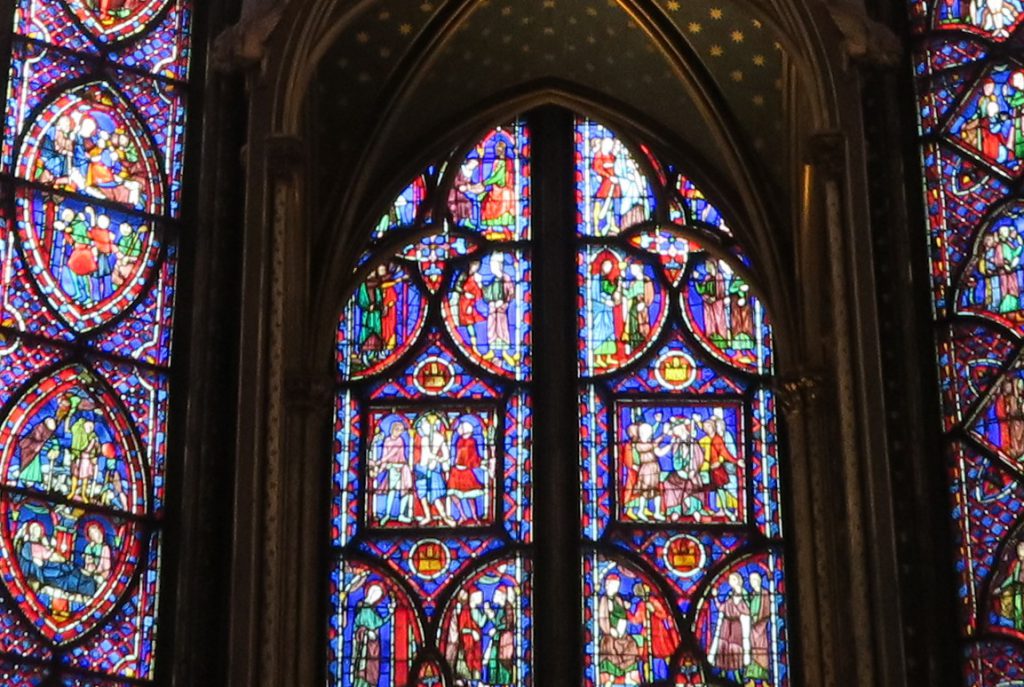
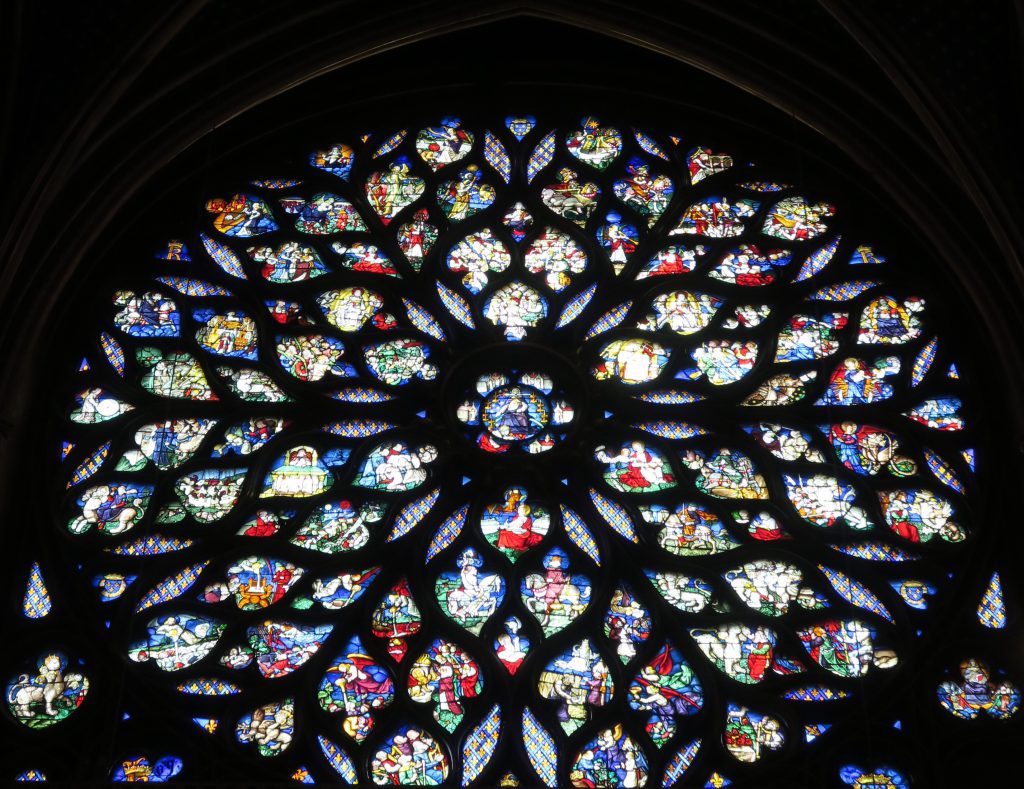
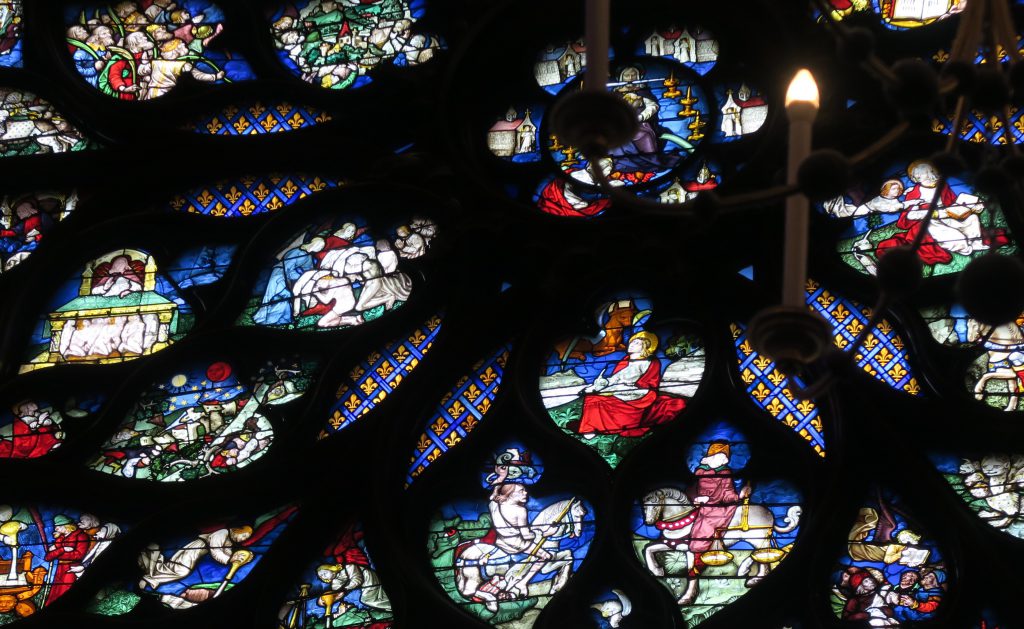
As Cohen concludes, “Once in operation, these [visual] attributes of the Sainte-Chapelle, combined with the mellifluous songs of the liturgy and heady perfume of the incense, created a multi-sensory experience that brought the terrestrial in communion with the divine.”17 It is no wonder the twelfth-century French writer Jean de Jandun praised it as “one of the best chambers of Paradise.”18
Paris as the Constantinople of the West
The timing of Louis IX’s commissioning of Sainte-Chapelle is significant—the royal chapel had been completed in the decade immediately prior to the king’s taking the cross and travelling east to the Holy Land. Daniel Weiss draws attention to this fact too, that Sainte-Chapelle was “produced under the auspices of the royal court during the years just preceding the crusade of 1248,” when he comments on the iconographical program of the stained-glass panels in the upper chapel.19 “[B]iblical kingship,” Weiss points out, “assumes an ancestral role both for Christ and for the Capetian dynasty in the guise of Louis IX, the only king of the Christian era pictured in the entire program.”20 In this way, the patron of Sainte-Chapelle—the king of France, but also one of the most famous crusaders believing himself to be on a sacred mission—had his identity and vision manifested physically in his chapel that likewise marries the idea of kingship and divinity in its program.
Not only does the iconographical program highlight both kingliness and saintliness, but the building’s architectural form does as well. Sainte-Chapelle’s longitudinal plan (Fig. 4) drew on precedents ranging from the Cappella Palatina to the Cámara Santa.21 Distinguishing features or forms (pinnacles, gables, fine window tracery) of prestigious cathedrals and churches, in particular those of the Sacra Capella of the Great Palace in Constantinople, were adopted and amalgamated at Sainte-Chapelle.
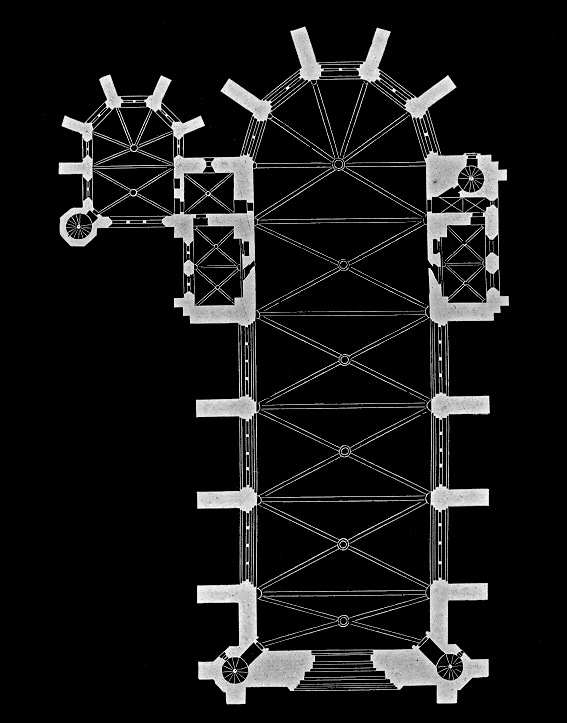
Both Branner and Weiss even point out that the name itself “Sainte-Chapelle” derived from the “Holy Chapel” inside the Byzantine Emperor’s Boucoleion Palace in Constantinople.22 Weiss provides a written description of the Holy Chapel by the French knight, Robert de Clari, a witness of the sack of Constantinople in 1204:
The one called the Holy Chapel [Sainte Capele], which was so rich and so noble that (…) no one could ever tell you its great beauty and nobility. Within this chapel were found many rich relics. One found there the two pieces of the True Cross as large as the leg of a man… [sic] and one found there the blessed crown with which He was crowned, which was made of reeds and thorns as sharp as the points of dagger.23
It is crystal clear from this passage that King Louis did not simply intend for Sainte-Chapelle to be a stylistic inheritor of the Holy Chapel of Constantinople, but that the architectural invocation symbolically highlighted that Paris had inherited the holy Passion relics from the Byzantine Empire. In like manner to King Louis IX’s invocation of biblical predecessors in Old Testament kings within the Arsenal Old Testament as argued by Weiss, Sainte-Chapelle works almost as an architectural quotation of earlier royal and ecclesiastical buildings for the sake of establishing authority.24 The right to rule, then, seems truly to be a divine right.
The Crown of Thorns—Journey to the Western World

The Crown of Thorns could be found at the far end of the chapel. It is a contact relic associated with Christ. It was mentioned in the Bible as one of the many instruments used before and during his crucifixion. As described in the gospel of Matthew, “And when they had plaited a crown of thorns, they put it upon his head, and a reed in his right hand: and they bowed the knee and mocked him, saying Hail! King of the Jews!” (Matthew 27:29) (Fig. 6).
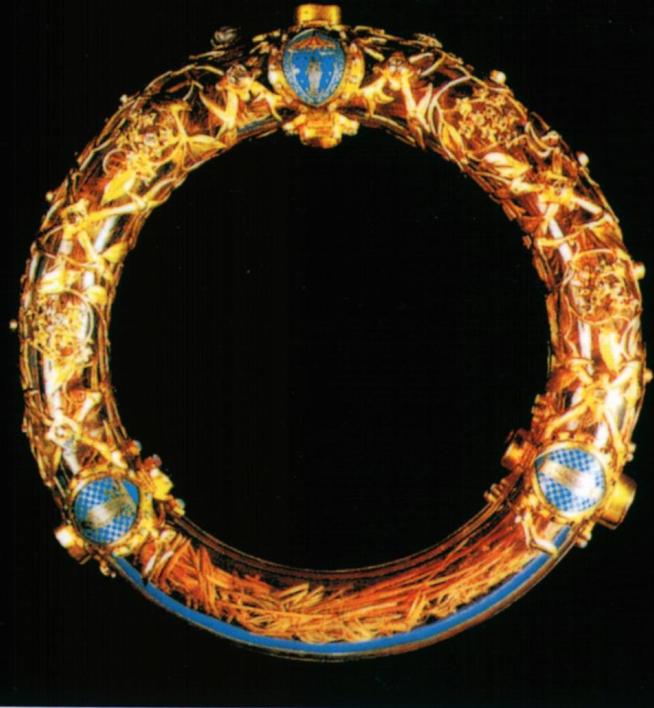
The relic (Fig. 7) was kept in a beautifully decorated reliquary, mounted in a crystal ring, formed by six pieces of crystals, each kept in place by three leaves of bronze and gilt.25 The decoration of the reliquary added value to the relic, with the most precious materials on Earth representing its holiness. By adorning reliquaries in such a lavish manner, power was added to the object and, by placing an object with divine power in a cathedral commissioned by royal power, both powers were combined.
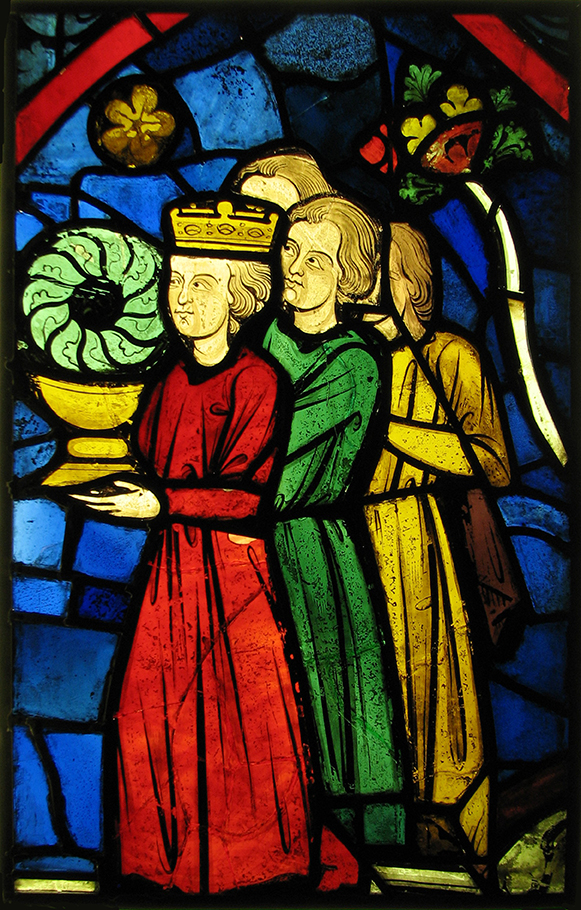
The Crown of Thorns is believed to have been hidden in Jerusalem in the first few centuries after the death of Christ, until St. Paulinus, bishop of Nola, spoke of its existence in the fifth century.26 After a number of negotiations with Baldwin II (the Latin emperor of Constantinople) and Pope Gregory IX, the Crown of Thorns was transferred from Constantinople to the Venetians, and finally to Paris, with Louis IX paying 13,134 pieces of gold to acquire it (Fig. 8).27 From the year 1248, it was held safely in Sainte-Chapelle until the French Revolution. The crown then found its new home in Notre Dame Cathedral in 1806, until a fire destroyed part of the cathedral in 2019.
The Combination of Royal and Divine Powers: A Demonstration of Supreme Kingship?
The acquisition of a holy relic is no ordinary transaction. It was packaged into a diplomatic exchange as a divine gift between nations. Such a noble transaction between powers is highly political and rationalized in the name of Christ. This showed the common line blurring between royal and divine powers. Often political power is used in the name of divine power in order to rationalize certain behaviors. The transferal of the Crown of Thorns is an example of this, with Louis IX becoming a “new protector” of the relic.28 In addition to re-making Paris as another Holy Land to prove his faith, Louis accelerated his temporal power by bringing divine power to his land; he thus used the crown to symbolize that he was a pious king, able to rule with divine authority. Moreover, Louis was canonized twenty-seven years after his death, in demonstration of his relic acquisition and possession.29 Sanctity and royalty is therefore combined in the transfer of relics.
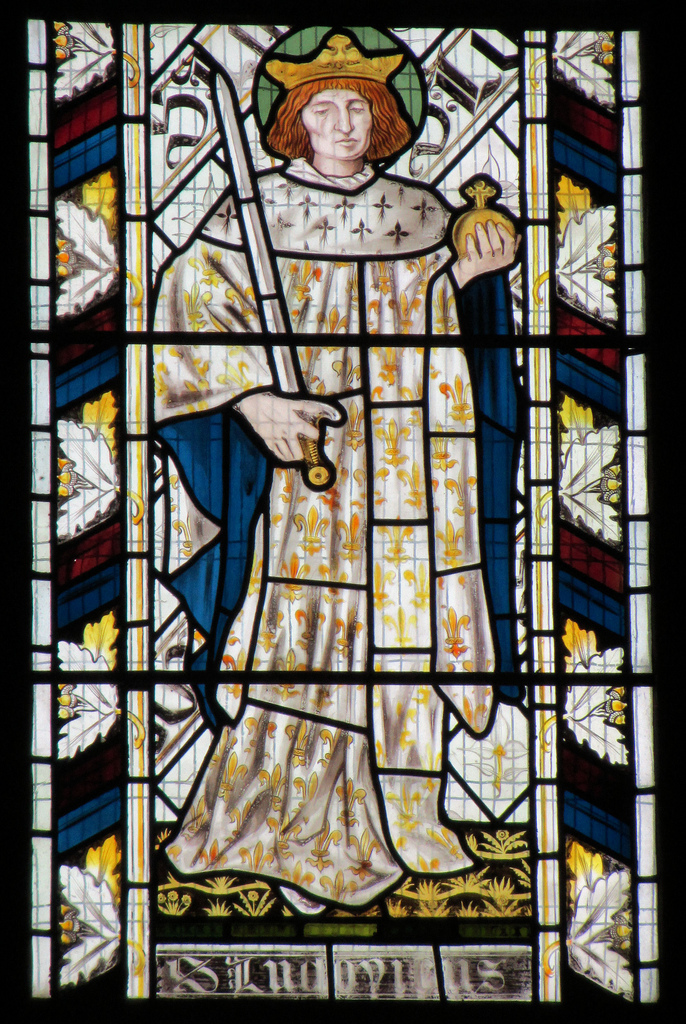
The Crown of Thorns symbolizes the kingship of Christ, as it was the crown worn upon his head before he sacrificed himself (although in a form of humiliation by the Roman soldiers) (Fig. 9).30 Relics were seen as symbols of saints’ power and presence; this one was of supreme importance in its intimate connection to Christ and his sacrifice. Louis brought the crown to Paris and built a cathedral for it. Bringing Christ’s crown to his homeland meant that he was also bringing Christ’s ruling power on Earth to his land, and thereby justifying his rule as a mortal king. Keeping the Crown of Thorns in Paris therefore fulfilled the Western expectation that owning a physical object of divinity indicated the presence of that divinity, in this case, Christ in the French capital. The crown relic was a symbol of divine power, held by the French court.
Into the Modern Age: The Separation of Sanctity and Royalty
Shortly after the French Revolution, the crown was moved to Notre Dame in 1806. It could then be worshiped by all of the people of Paris as a shared national treasure, available to the public at special services.31 The relic was originally held in Sainte-Chapelle, a place representing the combination of royal and divine power; however, the transition of the relic to Notre Dame symbolized a social change in France, when the form of government was radically altered after the French Revolution. When royal power diminished, divine power was gradually taken away from the ruling powers as the world slowly transitioned to the modern age. Therefore, the move of the crown to Notre Dame suggests the shift of French ruling power from the monarchy, where divine power is combined with royal power, to a more modern society.
Bibliography
Bony, Jean. French Gothic Architecture of the Twelfth and Thirteenth Centuries. Berkeley: University of California Press, 1983.
Branner, Robert. “The Painted Medallions in the Sainte-Chapelle in Paris.” Transactions of the American Philosophical Society 58, no.2 (1968): 1-42.
———. “The Sainte-Chapelle and the Capella Regis in the Thirteenth Century.” Gesta 10, no.1 (1971): 19-22.
Cohen, Meredith. The Sainte-Chapelle and the Construction of Sacral Monarchy: Royal Architecture in Thirteenth-Century Paris. Cambridge: Cambridge University Press, 2014.
———. “Metropolitan Architecture, Demographics, and the Urban Identity of Paris in the Thirteenth Century.” In Cities, Texts, and Social Networks, 400-1500: Experiences and Perceptions of Medieval Urban Space, edited by Caroline Goodson, Anne Lester, and Carol Symes, 65–102. Farnham, UK: Ashgate, 2010.
Gaposchkin, M.C. “Louis IX, crusade and the promise of Joshua in the Holy Land.” Journal of Medieval History 34 (2008): 245-74.
Guerry, Emily. “Notre Dame: How Christ’s Crown of Thorns Has Survived Crusades, Political Upheaval and a Fire (but Only Just).” The Conversation. April 19, 2019. http://theconversation.com/notre-dame-how-christs-crown-of-thorns-has-survived-crusades-political-upheaval-and-a-fire-but-only-just-115731 (accessed April 4, 2020).
Hourihane, Colum. The Grove Encyclopedia of Medieval Art and Architecture. New York: Oxford University Press, 2012.
Robbins, Rachel “Politics and Prestige: Five Hundred Years of Images of the Grande Châsse of the Sainte-Chapelle.” MA thesis, University of Alabama, 2014.
Wall, Charles. Relics from the Crucifixion: Where They Went and How They Got There.
Manchester, UK: Sophia Institute Press, 2015.
Weiss, Daniel H. “Architectural Symbolism and Decoration of the Ste.-Chapelle,” The Art Bulletin 77, no.2 (1995):
———. “Biblical History and Medieval Historiography: Rationalizing Strategies in Crusader Art.” MLN 108, no. 4 (1993): 710-37.
Weiss, Rachel. “Learning from Loss: Digitally Reconstructing the Trésor des Chartes of the Sainte-Chapelle.” MA thesis, University of California, 2016.
Image Credits
Header image. Source: “Sainte Chapelle @ Ile de la Cité @ Seine @ Paris” by GuilhemVellut is licensed under cc-by-2.0.https://commons.wikimedia.org/wiki/File:Sainte_Chapelle_@_Ile_de_la_Cit%C3%A9_@_Seine_@_Paris_(34281776341).jpg
Fig. 1 The baldachin at the apse. Photograph by Jean-Pierre Dalbéra, March 1, 2018. Source: Wikimedia Commons, https://commons.wikimedia.org/wiki/Category:Interior_of_Sainte-Chapelle_(Paris)#/media/File:L’abside_de_la_Sainte-Chapelle_(Paris)_(40560110131).jpg, licensed under CC BY 2.0
Fig. 2a Interior of Sainte-Chapelle. Photo © Gigi Leung.
Fig. 2b Close up of Fig. 2a. Photo © Gigi Leung.
Fig. 3a Rose window above the west door. Photo © Gigi Leung.
Fig. 3b Close-up of the rose window—note the fleur-de-lis. Photo © Gigi Leung.
Fig.4 Sainte-Chapelle’s ground plan. Source: Eugène Emmanuel Viollet-le-Duc, Dictionnaire raisonné de l’architecture française du XIe au XVIe siècle (Paris: A. Morel, 1875), digitalised by Internet Archive, taken from https://commons.wikimedia.org/w/index.php?title=File:Plan.sainte.chapelle.Vincenne.png&oldid=142251606. Modified image in the public domain.
Fig.5 Map of Paris. Source: Claes Janszoon Visscher, Lutetia Parisiorum urbs: toto orbe celeberrima notissimaque, caput regni Francia, 1618, print, 50 x 75 cm, digitalised by Internet Archive, taken from https://commons.wikimedia.org/w/index.php?title=File:Map_of_Paris_by_Claes_Jansz._Visscher_-_Harold_B._Lee_Library.jpg&oldid=346121559. Public domain.
Fig.6 Cristo Crucificado (Francisco de Zurbarán). Source: Wikimedia Commons, https://commons.wikimedia.org/wiki/File:Cristo_Crucificado_(Francisco_de_Zurbar%C3%A1n).jpg, licensed under CC-BY-SA-4.0.
Fig.7 Couronne d’epines – Crown of Thorns Notre Dame Paris. Source: Wikimedia Commons, https://commons.wikimedia.org/wiki/File:Couronne_d%27epines_-_Crown_of_Thorns_Notre_Dame_Paris.jpg, licensed under CC-BY-SA-2.5-, 2.0, 1.0.
Fig.8 King Louis IX Carrying the Crown of Thorns, ca. 1245–48. Source: The Metropolitan Museum of Art, https://www.metmuseum.org/art/collection/search/471218. Public domain.Fig.9 St. Louis IX, stained glass of the East window of All Saints Church in Cambridge, designed by Ford Madox Brown, late 19th century. Source: Wikimedia Commons, https://commons.wikimedia.org/wiki/File:St_Louis_IX.jpg, licensed under CC-BY-SA-3.0.
The Authors
Yuki Wong is a final-year student from the Faculty of Arts, currently minoring in Fine Arts.
Lau Lai Shan : An art lover. A Fine Arts major.

